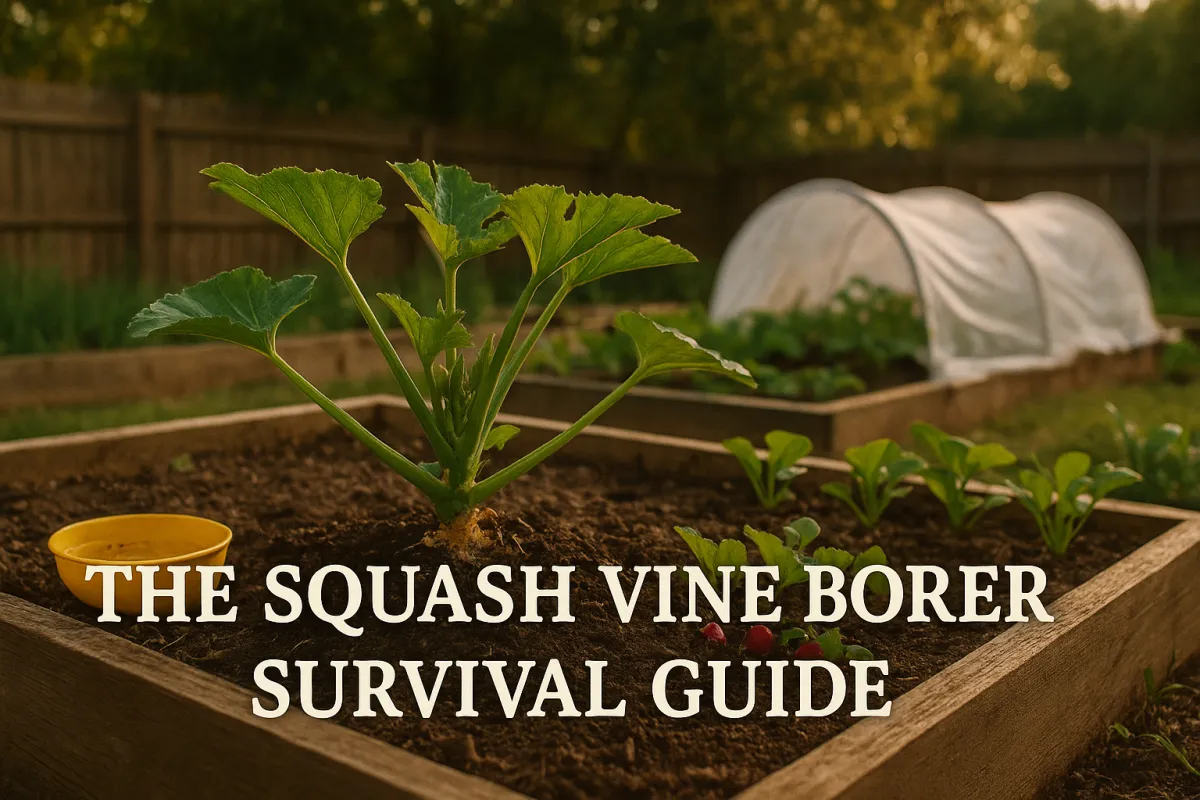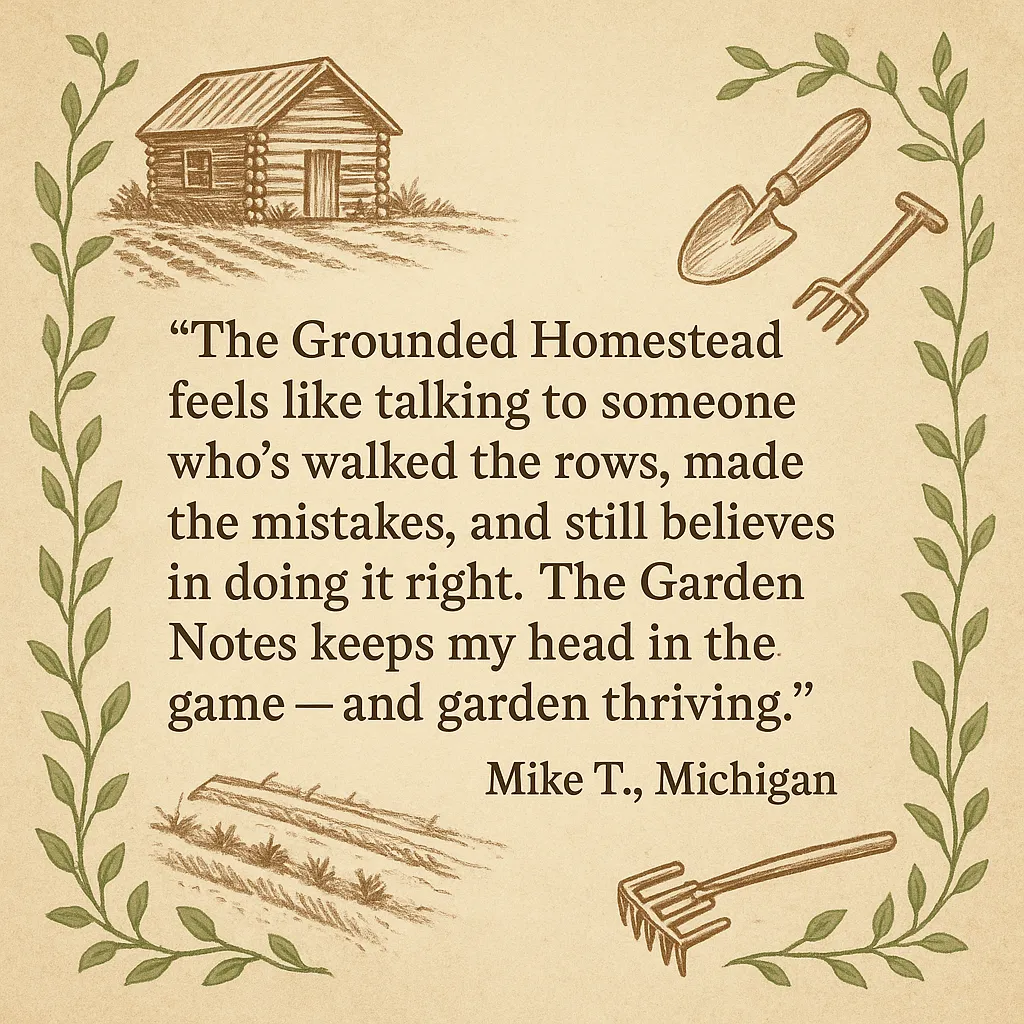
The Squash Vine Borer Survival Guide
The Squash Vine Borer Survival Guide
The Squash Vine Borer Survival Guide
Meet the Enemy: What Is a Squash Vine Borer?
The Lifecycle You Need to Know
Know the Signs Before It’s Too Late
Warning Signs of a Squash Vine Borer Infestation
Visual ID Guide (Keep These In Mind)
1. Floating Row Covers: Your First Line of Defense
2. Trap Monitoring for Timing and Action
3. Rotate Crops and Disrupt the Lifecycle
4. Build Soil Health for Resilient Plants
Surgery: Saving a Plant That’s Been Hit
Step-by-Step Guide: How to Save Your Squash
When Surgery Works (and When It Won’t)
Grow Resistant or Less-Preferred Varieties
Use Companion Planting as a Natural Deterrent
Stagger Plantings to Spread Risk
Remember: It’s Not Just Zucchini at Risk
Resilience Takes Root with Vigilance
The One That Got My Zucchini
It happened fast.
A few summers back, I walked out to the garden and found my strongest zucchini plant collapsed—wilted like it hadn’t been watered in a week. But the soil was moist, the leaves were healthy the day before, and nothing about the heat explained it.
That’s when I spotted the frass—little piles of sawdust near the plant stem. A squash vine borer had gotten in.
If you're growing summer squash, zucchini, or even pumpkins, you’re up against one of the most destructive pests in the home vegetable garden. Squash vine borers don't give second chances. Their larvae tunnel straight through the stem, cutting off water and nutrients from the inside out.
This guide will show you exactly how to spot the problem early, stop it before it starts, and—even if your crop’s already under attack—how to save your squash from vine borers with a hands-on survival strategy that works.

Meet the Enemy: What Is a Squash Vine Borer?
If you grow cucurbits—zucchini, pumpkin, butternut squash, or even cucumber—you’ve got one major enemy in the garden: the squash vine borer. This isn’t your average pest. It’s a silent killer that tunnels into the plant stem and destroys from within, long before most gardeners even realize what’s happening.
The adult is a day-flying moth that mimics a wasp. Its orange and black body, fast flight, and tendency to hover near the base of the plant makes it easy to mistake for something harmless. But this pest lays tiny, flat eggs near the crown of your squash, and that’s where the real damage begins.

The Lifecycle You Need to Know
Understanding the vine borer’s lifecycle is key to preventing infestation before it starts:
Adult moths emerge in late spring to early summer, depending on your climate and USDA zone.
After mating, they lay eggs at the base of host plants—typically summer squash, winter squash, pumpkins, and other cucurbita species.
When those eggs hatch, the larvae burrow into the plant stem, feeding for about 1–2 weeks.
By the time you notice wilting, the borer has already done the damage.
Eventually, the pupa drops into the soil, where it overwinters until next year.
Garden Note: The squash vine borer doesn’t just go after zucchini. It targets many warm-weather crops in the cucurbit family. Think pumpkin, acorn squash, tromboncino, and even some melons if conditions allow.
USDA Zone Emergence Guide

In warmer zones, a second generation may emerge in late summer.
For a detailed breakdown of the squash vine borer’s lifecycle—from egg to pupa—check out the University of Minnesota Extension’s guide, which walks through each stage and the timing in home garden conditions.

Know the Signs Before It’s Too Late
You don’t always see the squash vine borer coming. It doesn’t chew leaves or nibble fruit. Instead, it goes straight for the plant stem, burrows in, and eats from the inside out.
If you wait for obvious damage, it's already too late.
Warning Signs of a Squash Vine Borer Infestation
Watch closely for these early red flags:
Sudden mid-day wilting, even when soil is moist and the weather’s mild
Frass (sawdust-like droppings) at the base of the vine near the soil line
A small hole or soft, split area at the stem base
Adult moths flying low near squash stems—they look like red-orange wasps
A single leaf or vine dying while the rest of the plant looks healthy
Even one borer can take out a full-size zucchini. That’s why early detection is the backbone of squash vine borer prevention.

Visual ID Guide (Keep These In Mind)
Adult moth: Black wings, bright orange abdomen, fast-moving like a hornet
Frass: Tan or orange-ish sawdust; often wet and sticky
Larva: Creamy white caterpillar, about an inch long, with a brown head
Check your squash every few days. These signs show up fast—and knowing what to look for can mean the difference between saving a crop or starting over.

Your Prevention Toolkit
How to Keep the Squash Vine Borer Out of Your Garden for Good
When it comes to squash vine borer prevention, your best weapon is timing. Once the larva gets inside the plant stem, no spray or soil soak will reach it. That’s why serious gardeners focus on barrier methods, monitoring, and planting strategies that disrupt the borer’s cycle.
Here’s how to stay a step ahead:
1. Floating Row Covers: Your First Line of Defense
Cover squash seedlings immediately after planting
Secure all edges with soil, bricks, or landscape pins
Remove row covers when flowers appear to allow pollinators in
Best used for zucchini, yellow squash, cucumber, and young pumpkin vines
This simple floating row cover kit is my go-to for keeping moths off young squash vines without using a single drop of pesticide.

Tip: In areas with long growing seasons, consider planting a second wave of squash after peak borer season has passed.
2. Trap Monitoring for Timing and Action
Place yellow bowls filled with soapy water near your squash—moths are drawn to the color and drown
Add pheromone traps if you want precise timing for removal of row covers
Track moth activity with a weekly monitoring checklist
Seeing a red-orange moth hovering around your vines? It’s time to act. That’s your signal the eggs are being laid.
3. Rotate Crops and Disrupt the Lifecycle
Don’t plant cucurbits in the same bed two years in a row
Rotate with unrelated crops like beans, lettuce, or potatoes
Till the soil in fall to expose pupae and disrupt overwintering cycles
Remove all old vines and garden debris after harvest to eliminate hiding spots
4. Build Soil Health for Resilient Plants
Healthy soil won’t stop borers, but it will help your plants fight back:
Add compost to boost nutrient levels
Use mulch to retain moisture and stabilize soil temps
Incorporate cover crops or rotate with legumes to enhance organic matter
A squash plant growing in rich, loose soil has a better chance of surviving injury than one in compacted, nutrient-starved ground.
Penn State Extension reinforces the effectiveness of yellow bowl traps and timely row covers in preventing infestation—check their page for precise timing and placement tips.
Surgery: Saving a Plant That’s Been Hit
How to Save Squash from Vine Borers When It’s Not Too Late
If you spot frass at the base of the vine or catch the wilting early enough, you can still save your plant. This method isn’t pretty—but it works.
Gardeners call it vine surgery. You’ll open the stem, extract the borer, and encourage the plant to reroot. It’s the best shot at salvaging a crop mid-season.
Step-by-Step Guide: How to Save Your Squash
Find the frass. That’s your entry point.
Use a clean, sharp knife to make a lengthwise slit along the vine—just above and below the damage.
Carefully pry open the stem and remove the larva with tweezers.
Disinfect the wound with hydrogen peroxide or an alcohol wipe.
Mound moist soil or compost over the wounded stem to encourage new root growth at the site.
Water gently and shade if heat is intense for the next day or two.
Note: Most squash can reroot along buried stem sections, especially in warm, moist conditions.

What You’ll Need
Sharp garden knife or razor
Hydrogen peroxide or alcohol
Loose soil, compost, or worm castings
Optional: Diatomaceous earth around the base post-surgery for added protection
When Surgery Works (and When It Won’t)
✅ Plant still has turgid (firm) leaves on other vines
✅ Frass is fresh and damage is localized
❌ Entire vine is limp or collapsed
❌ Multiple borers have tunneled through the base
Grow Smarter Next Season
Long-Term Tactics to Outsmart the Squash Vine Borer Year After Year
Once you’ve dealt with a vine borer infestation, you never forget it. The goal moving forward is to grow in a way that makes your garden less inviting to pests—and more resilient when they do show up.
Here’s how to outsmart squash vine borers before they take root.
Grow Resistant or Less-Preferred Varieties
Some types of squash are far less appealing to vine borers:
Butternut squash
Cushaw
Tromboncino
Hybrid zucchini cultivars bred for resistance
Note: Avoid varieties like yellow crookneck and standard zucchini if borers are a regular problem—they’re highly susceptible.
Use Companion Planting as a Natural Deterrent
Integrate pest-repelling plants around your squash to confuse or deter borers and other insects:
Radish – natural pest repellent
Nasturtium (Tropaeolum) – draws away squash bugs
Tagetes (Marigold) – deters nematodes and leaf pests
Basil, catnip, and onions – all support integrated pest management
Interplanting herbs and flowers improves biodiversity and helps attract beneficial insects like parasitic wasps and lacewings.
Stagger Plantings to Spread Risk
Plant early, mid, and late-season squash in waves
If one crop is attacked, the others may escape peak moth activity
Use this method with succession planting to extend your harvest
Remember: It’s Not Just Zucchini at Risk
Squash vine borers also target:
Pumpkin
Acorn squash
Cucumbers (occasionally)
Melons and watermelons (in warm, humid climates)
Even eggplant and tomato stems can attract other boring insects if vines are weakened
Understanding how borers choose a host helps you prevent future damage.
Final Tip: Think Like a Pest
If you were a moth looking for a place to lay your eggs, what would you look for?
Bare soil, stressed plants, dense monocultures, and unchecked stems.
Don’t give them that option.
Resilience Takes Root with Vigilance
Learning to Outsmart the Squash Vine Borer—One Season at a Time
Every gardener eventually runs into something that humbles them. For me, it was the squash vine borer. One day I was staring at a lush zucchini patch; the next, I was pulling up wilted vines with larvae still inside the stems.
The truth is, how to save squash from vine borers isn’t just about reacting—it’s about understanding. It’s knowing the pest’s lifecycle, watching for frass, covering at the right time, and building in resilience through crop rotation, companion planting, and smarter timing.
You’re not just growing vegetables—you’re building a system. One that stands up to pests, weeds, heat, and mistakes. And every failed squash plant has something to teach you.
Frequently Asked Questions About Squash Vine Borers
What does squash vine borer damage look like?
The most common sign is sudden wilting of an otherwise healthy vine. Look closer and you’ll often see frass—orange-brown sawdust—near the base of the plant stem. That’s a sign the larva is already tunneling inside. If the vine feels soft or split, it's likely under attack.
When do squash vine borers appear?
Adult moths emerge from the soil in late spring to early summer—typically late May to early July, depending on your USDA zone. Zone 5 gardeners can expect activity around mid-June, while warmer zones may see them earlier and even get a second wave in late summer.
Do squash vine borers affect pumpkins and cucumbers too?
Yes. In addition to zucchini and summer squash, borers often target pumpkins, acorn squash, Cushaw, and sometimes cucumbers and melons, especially in hot, humid climates. They favor crops in the cucurbita family but have been seen around stressed tomato and eggplant stems as well.
Can I still eat squash from a plant that had vine borers?
Yes—if the fruit is intact and harvested before the vine completely collapses, it’s still good to eat. Be sure to check for soft spots or signs of rot near the stem end. If it’s firm and clean, enjoy it.
What’s the best natural method to prevent squash vine borers?
Your best bet is floating row covers, used early in the season to block the moth from laying eggs. Pair that with yellow bowl traps for monitoring, crop rotation, and companion planting with deterrent herbs like radish, basil, and catnip. These organic methods reduce your need for pesticides and support beneficial insects in your garden.
Does Bacillus thuringiensis (Bt) work on squash vine borers?
Yes—but only at the right stage. Bt must be applied to the stem just before or during egg hatch, before the larvae enter. Once inside the vine, it’s too late. Some gardeners inject Bt into the stem, but timing and technique are critical.
Can I use diatomaceous earth for vine borer prevention?
You can. Apply a thin layer of diatomaceous earth around the stem base in early summer. Reapply after rain. It can help deter the adult moth from laying eggs, but it works best as part of a broader prevention plan, not on its own.
Will tilling the soil help control squash vine borers?
Yes. Tilling in the fall or early spring helps expose and kill overwintering pupae. Removing plant debris and keeping the soil surface clean around squash crops also reduces next year’s risk.
Video Summary of this issue:
As always, the tools and supplies I mention are the same ones I rely on here at The Grounded Homestead. Some are affiliate links, which means I may earn a small commission—at no extra cost to you—but every recommendation is based on real use and trust.
Looking for more professional guidance & homesteading resources?
Explore our trusted guides to learn more about growing healthy food, managing your land, and building lasting systems for your homestead. Whether you're looking for planting tips, seasonal checklists, or natural solutions that actually work—we’ve got you covered.
Start with these helpful reads:
Everything to know about Strawberries:
Start with Strawberries: Ground Your Garden with Fruit that Grows Back
6 Common Strawberry Plant Diseases and How to Treat Them Naturally
The 6 Pests That Wreck Strawberry Crops—and How to Beat Them Naturally
Beyond Straw: Choosing the Right Mulch for Every Strawberry Bed
Runner Management 101: Multiply Your Strawberry Patch with Purpose
Frost, Flood, and Fungus: Protecting Strawberries in Extreme Weather
The Best Strawberry Varieties for Continuous Summer Harvests
Top 14 Practical Uses for Fresh Strawberries (Beyond Jam)
Start a U-Pick Strawberry Business (Even on 1 Acre)
How to Fertilize Strawberries for Yield, Flavor, and Runner Control
Strawberries in Small Spaces: Balcony, Border, and Vertical Growing Techniques
Wild Strawberries vs. Cultivated: Should You Grow Fragaria vesca?
The Complete Guide to Propagating Strawberries: Growing Strawberries from Seed
How to Integrate Strawberries Into a Permaculture Garden
How to build a low-maintenance 4-bed strawberry system’
Everything to know about Raspberries:
Start with Canes: How to Plant Raspberries for a Lifetime of Fruit
Raspberry Care 101: From Cane to Crop Without the Fuss
Build a Raspberry Trellis That Lasts: Sturdy DIY Designs for Any Backyard
When and How to Cut Back Raspberries: The Right Way to Prune Summer and Fall Types
Raspberry Troubleshooting Guide: Yellow Leaves, No Fruit, and Cane Dieback
Raspberry Pest Guide: What’s Bugging Your Patch (and What to Do About It)
Everything to know about Lettuce:
Lettuce 101: How to Grow Crisp, Clean Greens Anywhere
The Lettuce Succession Plan: How to Get a Salad Every Week from Spring to Fall
Top 5 Lettuce Diseases—and What to Do When They Show Up
Top 5 Lettuce Mistakes New Gardeners Make
Top 5 Lettuce Pests—And How to Keep Them Out Naturally
Everything to know about Tomatoes:
Tomatoes 101: How to Grow Strong, Productive Plants from Seed to Sauce
Tomato Feeding Guide: What to Add, When to Add It, & How to Avoid Overdoing It
The Top 5 Tomato Problems—And How to Fix Them Before They Ruin Your Harvest
Pruning Tomatoes: When, Why, and How to Do It Without Hurting Your Plants
The Top 5 Mistakes First-Time Tomato Growers Make (And How to Avoid Them)
Everything to know about Kale:
The Top 5 Kale Pests — How to Protect Kale from Bugs Organically
How to Harvest Kale the Right Way (So It Keeps on Giving)
Kale 101: A No-Fuss Guide to Growing Tough, Nutritious Greens
What to Do When Kale Looks Rough: Yellowing, Holes, or Curling Leaves
Kale Varieties Demystified: What to Grow and Why It Matters
How to Keep Kale from Getting Bitter (Even in Warmer Months)
Everything to know about Kale:
Green Beans 101: Planting, Caring, and Harvesting for Steady Summer Yields
The Top 5 Green Bean Problems—and How to Fix Them Naturally
Succession Planting Green Beans for a Full Summer Harvest
The Top 5 Pests That Wreck Green Beans—And What to Do About Them
Bush vs. Pole Beans: Which Is Better for Your Garden?
Everything to know about Zucchini
Zucchini & Summer Squash 101: Planting, Caring, and Harvesting for Massive Yields
The Top 5 Zucchini Problems—And How to Solve Them Naturally
Companion Planting with Zucchini: What Helps and What Hurts
Harvesting Zucchini the Right Way (and Why Size Matters)
Other Offerings:
The Summer Garden Reset: What to Do After Your First Harvest
How to Keep a Backyard Garden Alive in 90° Heat (Without Daily Watering)


Facebook
Instagram
X
Youtube